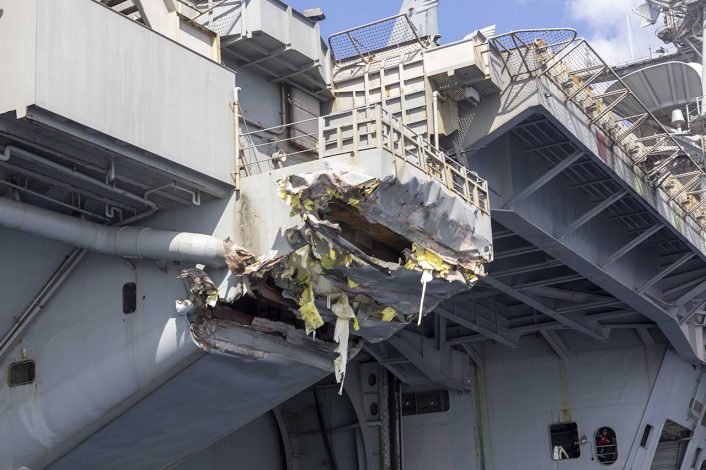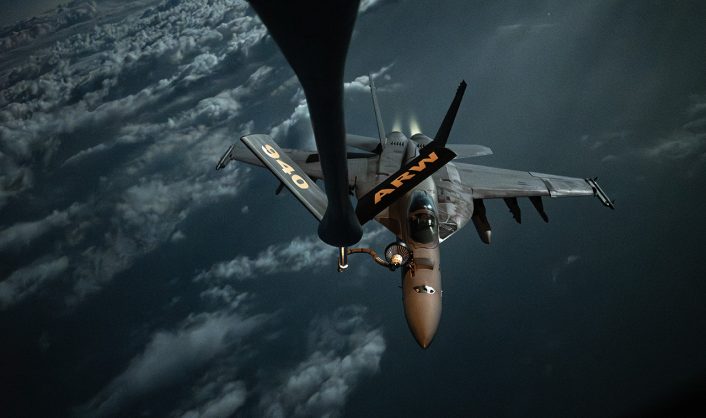After an eventful deployment to Europe and the Red Sea, the Nimitz class aircraft carrier USS Harry S. Truman (CVN 75) berthed at Naval Station Norfolk on Jun. 1, 2025.
Upon beginning its deployment, it was already expected that the USS Harry S. Truman would likely come to face hostile fire and launch live combat sorties. Departing the U.S. in September 2024, the carrier traveled to Europe and took part in exercises in the North Sea before relieving the USS Abraham Lincoln (CVN 72) in the Eastern Mediterranean and the Red Sea.
The Lincoln had been deployed to the region to counter Iranian threats against Israel, but ultimately turned its attention towards Houthi forces in Yemen who continued to attack shipping with missiles and drones. Counter strikes launched from the carrier saw the F-35C Lightning II fly its first ever combat missions.
Just a week after entering the Red Sea, the Truman launched its first airstrikes in Yemen as part of Operation Prosperity Guardian. The following day, the first of the deployment’s several unusual incidents took place when an F/A-18F Super Hornet from the carrier was shot down by the Ticonderoga class guided missile cruiser USS Gettysburg (CG 64). Both crew members were recovered, although one suffered minor injuries. The friendly fire incident reportedly took place while the F/A-18F was operating as a buddy tanker, presumably mistaken for an incoming drone or missile by personnel on board the cruiser.
Throughout January 2025, aircraft from the Truman and missiles from its escorts continued to target Houthi forces in Yemen. Houthi-aligned media and individuals, in response, frequently claimed (assisted by AI generated imagery) that the group had successfully attacked the carrier strike group, but in actuality scored no direct hits. On Jan. 12, the carrier was visited by General Michael Kurilla, Commander of the U.S. Central Command (CENTCOM).
USCENTCOM Commander Visits USS Harry S. Truman Carrier Strike Group
On 12 January, Gen. Michael Erik Kurilla, Commander of United States Central Command (CENTCOM), visited the aircraft carrier USS Harry S. Truman (CVN 75) as it operated in the Red Sea as part of ongoing… pic.twitter.com/UGYUDiA2gP
— U.S. Central Command (@CENTCOM) January 12, 2025
On Feb. 1, attention turned away from the Houthis and towards ISIS in Somalia. A huge operation involving at least 16 Super Hornets was launched from the Truman in what was subsequently described as the largest airstrike in history launched from a single carrier. A total of 125,000 lb of munitions were employed against a cave structure used by ISIS cell leaders, killing the primary target Ahmed Maeleninine along with 13 others.
Collision
Having exited the Red Sea for a brief stop at Souda Bay, Crete, the USS Harry S. Truman was subsequently involved in an at-sea collision near Port Said, Egypt. The Panamanian flagged merchant vessel Besiktas-M collided with the carrier’s starboard rear quarter at around 11:46PM local time on Feb. 12, causing visible damage but no flooding or injuries. By Feb. 17, the Truman returned once again to Souda Bay for repairs.

Several days later, it was revealed that the ship’s commanding officer, Captain Dave Snowden, was relieved of his command. In his place, the U.S. Navy installed Captain Christopher ‘Chowdah’ Hill, who had previously earned recognition for his leadership style and use of social media while commanding the USS Dwight D. Eisenhower in the Red Sea.
It is likely that more permanent repairs resulting from this incident will now take place. An in-depth U.S. Navy investigation into the collision is in progress.
Strike Two and Three
Compounding the loss of the F/A-18F Super Hornet to friendly fire in December, the Truman would go on to lose two more Super Hornets from its air wing by the end of its deployment.
On Apr. 28, an F/A-18E Super Hornet from Strike Fighter Squadron (VFA) 136 was lost overboard while the carrier operated in the Red Sea. Reportedly, the incident took place as a result of the ship taking evasive action in response to incoming fire from Houthi forces. The roll of the ship during a tight turn seemingly caused the aircraft, and the aircraft tractor attached to it, to simply slide off the carrier and into the sea.
No lives were lost in this dangerous occurrence, but one member of the ship’s crew suffered a minor injury.
UPDATE: A US official said that initial reports from the scene indicated that the Truman made a hard turn to evade Houthi fire, which contributed to the fighter jet falling overboard. https://t.co/TqrvCDUy3T https://t.co/2NFimBjl0A
— Natasha Bertrand (@NatashaBertrand) April 28, 2025
Only days afterward, an F/A-18F Super Hornet crashed into the sea while landing on the carrier in what appears to have been an arresting wire malfunction. It is not known exactly how this occurred, or why the aircraft was unable to recover by performing a ‘bolter’. Once again, both crew members were able to eject from the aircraft and were recovered by helicopter with minor injuries.
Both of these losses occurred during a period of intense U.S. military strikes against Houthi targets, under what was codenamed Operation Rough Rider. A ceasefire deal, reportedly as a result of President Trump growing weary of a protracted conflict, was reached with the Houthis around the same time as the second Super Hornet was lost. This deal appears to have remained in force, with no further attacks against shipping reported since.

The Royal Navy’s Prince of Wales carrier strike group successfully transited the Red Sea in late May and early June without any reported issues, although it maintained a high alert status with F-35B Lightning IIs and Wildcat HMA2 helicopters as a precaution. Other than the Prince of Wales, the Red Sea has been carrier free since the Truman’s departure. The closest U.S. carrier is the USS Carl Vinson (CVN 70) operating in the Arabian Sea off Oman.
Homeward Bound
The USS Harry S. Truman left the Red Sea via the Suez Canal on May. 17 and took part in some NATO exercises as it transited the Mediterranean Sea westbound for the Atlantic and its homeport. After a relatively quick ocean transit – the ship’s deployment had already been extended a number of times – the crew were almost certainly glad to arrive home in early June.
USS Harry S. Truman returns to Norfolk after an extended deployment, reuniting sailors with their families. pic.twitter.com/IwOo75iHHE
— 13News Now (@13NewsNow) June 1, 2025
The squadrons of the embarked Carrier Air Wing 1 (CVW-1) returned to their respective bases in the days prior, and were greeted by equally excited friends and family.
Welcome home, Strike Fighter Squadron (VFA) 143!!
VFA-143, part of Carrier Air Wing (CVW) 1, deployed on USS Harry S. Truman (CVN 75) and returned to Naval Air Station Oceana May 30 following an eight-month deployment to the U.S. 5th and 6th Fleet areas of operations. pic.twitter.com/MJtdw50bgm
— U.S. Fleet Forces (@USFleetForces) May 31, 2025
U.S. military news outlet Stars and Stripes called the deployment “brutal”, while Captain Hill said his crew had “demonstrated superb grit for more than eight months”. “Even in the face of significant challenges, they persevered, never giving up when their nation needed them. It’s been an honor to serve alongside such dedicated professionals and to take them home to their families,” he added.
After a number of years as one of the most active U.S. Navy aircraft carriers, the USS Harry S. Truman is soon scheduled to enter an almost $1 billion refueling and complex overhaul (RCOH) process at Huntington Ingalls Industries’ dedicated facilities in Newport News.
RCOHs take a number of years to complete, and usually take place around halfway through a carrier’s expected service life. Previous proposals would have seen the Truman retired to save costs, but this was rejected by Congress. Going ahead with the overhaul will mean the Truman can remain in active service through to the late 2040s and possibly beyond.









